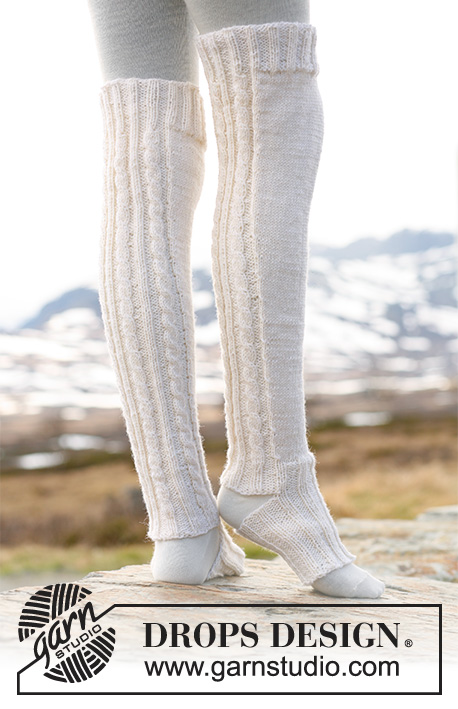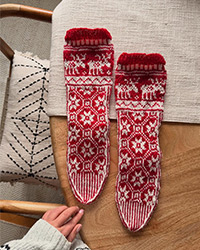Comments / Questions (14)
![]() Patricia Olivia Fuchs wrote:
Patricia Olivia Fuchs wrote:
Gibt es ein Video zum Stricktipp "In der ersten M. die abgekettet wurde 1 M. aufnehmen und diese bei der nächsten R. mit der vorherigen M. zusammenstricken damit der Übergang zwischen Abkett- und Anschlagskante sich nicht ausweitet." Wie soll das gehen? Ich bin ratlos :-(
18.10.2020 - 18:26DROPS Design answered:
Liebe Frau Fuchs, dafür haben wir kein Video: ketten Sie die 24 Maschen dann, bei der nächsten Runde, fassen Sie 1 Maschen aus der 1. abgekettene Maschen, schlagen Sie 24 neuen Maschen und stricken die Runde wie zuvor. Bei der nächsten Runde stricken Sie bis die aufgefassene Masche, diese Masche stricken Sie zusammen mit der 1. der 24 angeschlagenen Maschen und wie zuvor weiter stricken. Viel Spaß beim stricken!
19.10.2020 - 09:22
![]() Yaël Pustilnicov wrote:
Yaël Pustilnicov wrote:
Bonsoir, J'aimerai comprendre comment fonctionnent les indications doit-on prendre les chiffres par exemple pour la première : 4-3-5 cm ce sont pour les tailles 35/37-41/43-38/40 ? Merci pour votre réponse, YP
21.01.2015 - 23:20DROPS Design answered:
Bonjour Mr Pustilnicov, les nombres indiqués sont dans l'ordre des tailles, ainsi, on monte 63 m en taille 35/37, 70 m en taille 38/40 et 72 m en taille 41/43, ces nombres seront toujours dans cet ordre, ainsi, on commence à diminuer à 4 cm en taille 35/37, à 3 cm en taille 38/40 et à 5 cm en taille 41/43. Bon tricot!
22.01.2015 - 10:17
![]() Grete Larsen wrote:
Grete Larsen wrote:
Syns det er rart at det på str.38-40 skal stå, når arb. måler 3 cm felles...... Videre når arb. måler 9 cm, videre 12 cm, mens det på mindre str. strikkes flere cm. Er det feil eller?
11.07.2013 - 17:15
![]() DROPS Design wrote:
DROPS Design wrote:
Sticka upp 1 maska i den första maskan som blev avmaskad, på nästa varv stickas denna maska tillsammans med maskan före. Detta görs för att inte maskan mellan avmasknings- och uppläggningskanten ska dra sig.
08.01.2010 - 14:34
![]() DROPS Design wrote:
DROPS Design wrote:
Hej Jeanette, titta på stickhjälp på mönstret!
08.01.2010 - 14:33
![]() Jeanette wrote:
Jeanette wrote:
Hur gör man uppläggningen över avmaskningen?
27.12.2009 - 11:06
![]() Chatinot wrote:
Chatinot wrote:
Je cherche le même pour bébés et enfants !!!
05.12.2009 - 16:48Francesca wrote:
These are great yoga socks but should leave the ball and not just the toes of the foot exposed for grip. Thanks for this pattern!
19.08.2009 - 08:26
![]() Vdvnellain wrote:
Vdvnellain wrote:
Astucieux et plus simples que les chaussettes traditionnelles. Cela me donne envie d'essayer.
17.06.2009 - 14:42
![]() Emma wrote:
Emma wrote:
Jag försöker att lära mig att sticka och dom här var supersöta. Men man kanske måste använda strumpstickor till dess och det tycker jag är för svårt.
10.06.2009 - 18:38
Get a Grip Yoga Sock#getagripyogasock |
|
|
|
|
DROPS yoga Socks in ”Merino Extra Fine”.
DROPS 117-27 |
|
|
KNITTING TIP: Pick up 1 st in the first st that was bind off, on next round K this st tog with the st before. (to keep bind off and cast on rows in place). -------------------------------------------------------- -------------------------------------------------------- SOCK: Cast on 63-70-72 sts on double pointed needles size 3.5 mm / US 4 with Merino. K 2 rounds and continue in rib as follows: SIZE 5/6½ + 9½/10½ (35/37+41/43): K3/ P6. SIZE 7½/9 (38/40): K3/ P7. When piece measures 4-3-5 cm / 1½"-1⅛"-2" dec 1 st in every other P-section. When piece measures 8-6-10 cm / 3⅛"-2⅜"-4" dec 1 st in the remaining P-sections = 56-63-64 sts. Continue with K over K and P over P. SIZE 5/6½ (35/37): When piece measures 12 / 4¾" dec 1 st in every other P-section. When piece measures 16 cm / 6¼" dec 1 st in the remaining P-sections = 49 sts SIZE 7½/9 (38/40): When piece measures 9 cm / 3½" dec 1 st in every other P-section. When piece measures 12 cm / 4¾" dec 1 st in the remaining P-sections. When piece measures 15 cm / 6" dec 1 st in every other P-section. When piece measures 18 cm / 7" dec 1 st in the remaining P-sections = 49 sts. SIZE 9½/10½ (41/43): When piece measures 15 cm / 6" dec 1 st in every other P-section. When piece measures 20 cm / 8" dec 1 st in the remaining P-sections = 56 sts ALL SIZES: 49-49-56 sts. Continue in rib K3/ P4 until piece measures 21-23-25 cm / 8¼"-9"-9¾". Now bind off the first 24 sts and work remaining sts on round. On next round cast on 24 new sts over the bind off sts. See KNITTING TIP! Continue in the round with K3/ P4. When piece measures 2 cm / ¾" from the new 24 sts dec 1 st in every other P-section. When piece measures 7-8-8 cm / 2¾"-3⅛"-3 1/5" from the new 24 sts dec 1 st in the remaining P-sections = 42-42-48 sts. Continue in rib K3/ P3 and bind off all sts with K over K and P over P when piece measures 12-13-14 cm / 4¾"-5⅛"-5½" from the new 24 sts. |
|
Have you finished this pattern?Tag your pictures with #dropspattern #getagripyogasock or submit them to the #dropsfan gallery. Do you need help with this pattern?You'll find 9 tutorial videos, a Comments/Questions area and more by visiting the pattern on garnstudio.com. © 1982-2025 DROPS Design A/S. We reserve all rights. This document, including all its sub-sections, has copyrights. Read more about what you can do with our patterns at the bottom of each pattern on our site. |











































Post a comment to pattern DROPS 117-27
We would love to hear what you have to say about this pattern!
If you want to leave a question, please make sure you select the correct category in the form below, to speed up the answering process. Required fields are marked *.